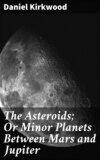Читать книгу: «The Asteroids; Or Minor Planets Between Mars and Jupiter», страница 3
5. Magnitudes of the Asteroids
The apparent diameter of the largest is less than one-second of arc. They are all too small, therefore, to be accurately measured by astronomical instruments. From photometric observations, however, Argelander,3 Stone,4 and Pickering5 have formed estimates of the diameters, the results giving probably close approximations to the true magnitudes. According to these estimates the diameter of the largest, Vesta, is about three hundred miles, that of Ceres about two hundred, and those of Pallas and Juno between one and two hundred. The diameters of about thirty are between fifty and one hundred miles, and those of all others less than fifty; the estimates for Menippe and Eva giving twelve and thirteen miles respectively. The diameter of the former is to that of the earth as one to six hundred and sixty-four; and since spheres are to each other as the cubes of their diameters, it would require two hundred and ninety millions of such asteroids to form a planet as large as our globe. In other words, if the earth be represented by a sphere one foot in diameter, the magnitude of Menippe on the same scale would be that of a sand particle whose diameter is one fifty-fifth of an inch. Its surface contains about four hundred and forty square miles,—an area equal to a county twenty-one miles square. The surface attractions of two planets having the same density are to each other as their diameters. A body, therefore, weighing two hundred pounds at the earth's surface would on the surface of the asteroid weigh less than five ounces. At the earth's surface a weight falls sixteen feet the first second, at the surface of Menippe it would fall about one-fourth of an inch. A person might leap from its surface to a height of several hundred feet, in which case he could not return in much less than an hour. "But of such speculations," Sir John Herschel remarks, "there is no end."
The number of these planetules between the orbits of Mars and Jupiter in all probability can never be known. It was estimated by Leverrier that the quantity of matter contained in the group could not be greater than one-fourth of the earth's mass. But this would be equal to five thousand planets, each as large as Vesta, to seventy-two millions as large as Menippe, or to four thousand millions of five miles in diameter. In short, the existence of an indefinite number too small for detection by the most powerful glasses is by no means improbable. The more we study this wonderful section of the solar system, the more mystery seems to envelop its origin and constitution.
6. The Orbits of the Asteroids
The form, magnitude, and position of a planet's orbit are determined by the following elements:
1. The semi-axis major, or mean distance, denoted by the symbol a.
2. The eccentricity, e.
3. The longitude of the perihelion, π.
4. The longitude of the ascending node, ☊.
5. The inclination, or the angle contained between the plane of the orbit and that of the ecliptic, i.
And in order to compute a planet's place in its orbit for any given time we must also know
6. Its period, P, and
7. Its mean longitude, l, at a given epoch.
These elements, except the last, are given for all the asteroids, so far as known, in Table II. In column first the number denoting the order of discovery is attached to each name.
TABLE II.
Elements of the Asteroids

PART II.
DISCUSSION OF THE FACTS IN TABLE II
1. Extent of the Zone
In Table II. the unit of column a is the earth's mean distance from the sun, or ninety-three million miles. On this scale the breadth of the zone is 1.8196. Or, if we estimate the breadth from the perihelion of Æthra (1.612) to the aphelion of Andromache (4.726), it is 3.114,—more than three times the radius of the earth's orbit. A very remarkable characteristic of the group is the interlacing or intertwining of orbits. "One fact," says D'Arrest, "seems above all to confirm the idea of an intimate relation between all the minor planets; it is, that if their orbits are figured under the form of material rings, these rings will be found so entangled that it would be possible, by means of one among them taken at hazard, to lift up all the rest."6 Our present knowledge of this wide and complicated cluster is the result of a vast amount, not only of observations, but also of mathematical labor. In view, however, of the perturbations of these bodies by the larger planets, and especially by Jupiter, it is easy to see that the discussion of their motions must present a field of investigation practically boundless.
While the known minor planets were but few in number the theory of Olbers in regard to their origin seemed highly probable; it has, however, been completely disproved by more recent discoveries. The breadth of the zone being now greater than the distance of Mars from the sun, it is no more probable that the asteroids were produced by the disruption of a single planet than that Mercury, Venus, the earth, and Mars originated in a similar manner.
2. The Small Mass of the Asteroids
In taking a general view of the solar system we cannot fail to be struck by the remarkable fact that Jupiter, whose mass is much greater than that of all other planets united, should be immediately succeeded by a region so nearly destitute of matter as the zone of asteroids. Leverrier inferred from the motion of Mars's perihelion that the mass of Jupiter is at least twelve hundred times greater than that of all the planets in the asteroid ring. The fact is suggestive of Jupiter's dominating energy in the evolution of the asteroid system. We find also something analogous among the satellites of Jupiter, Saturn, and Uranus. Jupiter's third satellite, the largest of the number, is nearly four times greater than the second. Immediately within the orbit of Titan, the largest satellite of Saturn, occurs a wide hiatus, and the volume of the next interior satellite is to that of Titan in the ratio of one to twenty-one. In the Uranian system the widest interval between adjacent orbits is just within the orbit of the bright satellite, Titania.
The foregoing facts suggest the inquiry, What effect would be produced by a large planet on interior masses abandoned by a central spheroid? As the phenomena in all instances would be of the same nature, we will consider a single case,—that of Jupiter and the asteroids.
The powerful mass of the exterior body would produce great perturbations of the neighboring small planets abandoned at the solar equator. The disturbed orbits, in some cases, would thus attain considerable eccentricity, so that the matter moving in them would, in perihelion, be brought in contact with the equatorial parts of the central body, and thus become reunited with it.7 The extreme rarity of the zone between Mars and Jupiter, regarded as a single ring, is thus accounted for in accordance with known dynamical laws.
Покупайте книги и получайте бонусы в Литрес, Читай-городе и Буквоеде.
Участвовать в бонусной программе















